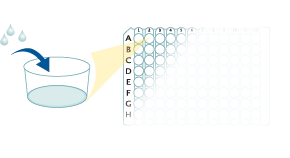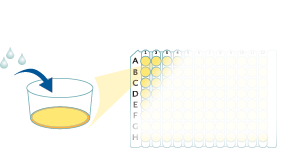Rat CXCL1/CINC-1 Quantikine ELISA Kit Summary
Product Summary
Recovery
The recovery of rat CINC-1 spiked to levels throughout the range of the assay in various matrices was evaluated.
| Sample Type | Average % Recovery | Range % |
|---|---|---|
| Cell Culture Supernates (n=4) | 99 | 93-106 |
| EDTA Plasma (n=4) | 97 | 90-104 |
| Heparin Plasma (n=4) | 99 | 90-113 |
| Serum (n=5) | 95 | 89-103 |
Linearity
Scientific Data
Product Datasheets
Preparation and Storage
Background: CXCL1/GRO alpha/KC/CINC-1
CXCL1/GRO alpha, also known as KC in mouse and CINC-1 in rat, is a member of the CXC family of chemokines. Human CXCL1/GRO alpha is 107 amino acids (aa) in length with a predicted molecular weight of 11 kDa. The mouse and rat orthologs share 57% and 59% amino acid sequence identity with the human protein, respectively. Genome-wide analysis suggests that the protein encoded by the mouse Cxcl3 gene is homologous to human CXCL1/GRO alpha protein. Human CXCL1/GRO alpha can be cleaved into three isoforms CXCL1/GRO alpha (aa 4-73), CXCL1/GRO alpha (aa 5-73), and CXCL1/GRO alpha (aa 6-73) which show higher activity than the full length protein. CXCL1/GRO alpha is secreted by mast cells and macrophages whereupon it acts as a chemoattractant for neutrophils.
Assay Procedure
Refer to the product- Prepare all reagents, standard dilutions, and samples as directed in the product insert.
- Remove excess microplate strips from the plate frame, return them to the foil pouch containing the desiccant pack, and reseal.
- Add 50 µL of Assay Diluent to each well.
- Add 50 µL of Standard, Control, or sample to each well. Cover with a plate sealer, and incubate at room temperature for 2 hours.
- Aspirate each well and wash, repeating the process 4 times for a total of 5 washes.
- Add 100 µL of Conjugate to each well. Cover with a new plate sealer, and incubate at room temperature for 2 hours.
- Aspirate and wash 5 times.
- Add 100 µL Substrate Solution to each well. Incubate at room temperature for 30 minutes. PROTECT FROM LIGHT.
- Add 100 µL of Stop Solution to each well. Read at 450 nm within 30 minutes. Set wavelength correction to 540 nm or 570 nm.





Citations for Rat CXCL1/CINC-1 Quantikine ELISA Kit
R&D Systems personnel manually curate a database that contains references using R&D Systems products. The data collected includes not only links to publications in PubMed, but also provides information about sample types, species, and experimental conditions.
23
Citations: Showing 1 - 10
Filter your results:
Filter by:
-
Targeting caveolae to pump bispecific antibody to TGF-beta into diseased lungs enables ultra-low dose therapeutic efficacy
Authors: AH Kadam, K Kandasamy, T Buss, B Cederstrom, C Yang, S Narayanapi, J Rodriguez, MD Levin, J Koziol, B Olenyuk, Z Borok, A Chrastina, JE Schnitzer
PLoS ONE, 2022-11-22;17(11):e0276462.
Species: Rat
Sample Types: BALF
-
Effect of Different Molecular Weights of Polyacrylic Acid on Rat Lung Following Intratracheal Instillation
Authors: C Nishida, H Izumi, T Tomonaga, KY Wang, H Higashi, JI Takeshita, R Ono, K Sumiya, S Fujii, Y Hata, K Sakurai, Y Higashi, K Yamasaki, K Yatera, Y Morimoto
International Journal of Molecular Sciences, 2022-09-07;23(18):.
Species: Rat
Sample Types: BALF
-
Sex-specific maternofetal innate immune responses triggered by group B Streptococci
Authors: MJ Allard, A Giraud, M Segura, G Sebire
Sci Rep, 2019-06-13;9(1):8587.
Species: Rat
Sample Types: Protein
-
Dexamethasone-induced Intra-Uterine Growth Restriction impacts NOSTRIN and its downstream effector genes in the rat mesometrial uterus
Authors: S Chakrabort, S Islam, S Saha, R Ain
Sci Rep, 2018-05-29;8(1):8342.
Species: Rat
Sample Types: Tissue Homogenates
-
The mitochondrial inhibitor oligomycin induces an inflammatory response in the rat knee joint
Authors: C Vaamonde-G, J Loureiro, MN Valcárcel-, RR Riveiro-Na, O Ramil-Góme, L Hermida-Ca, A Centeno, R Meijide-Fa, FJ Blanco, MJ López-Arma
BMC Musculoskelet Disord, 2017-06-12;18(1):254.
Species: Rat
Sample Types: Tissue Homogenates
-
Assessment of Pulmonary Toxicity Induced by Inhaled Toner with External Additives
Authors: T Tomonaga, H Izumi, Y Yoshiura, T Myojo, T Oyabu, BW Lee, T Okada, Y Li, K Kawai, T Higashi, Y Morimoto
Biomed Res Int, 2017-01-16;2017(0):4245309.
Species: Mouse
Sample Types: Tissue Homogenates
-
[EXPRESS] The Chemokine Receptor CXCR2 Supports Nociceptive Sensitization after Traumatic Brain Injury
Authors: DY Liang, X Shi, P Liu, Y Sun, P Sahbaie, WW Li, DC Yeomans, JD Clark
Mol Pain, 2017-01-01;13(0):1744806917730.
Species: Rat
Sample Types: Tissue Homogenates
-
Effect of Silodosin, an Alpha1A-Adrenoceptor Antagonist, on Ventral Prostatic Hyperplasia in the Spontaneously Hypertensive Rat.
Authors: Shimizu S, Shimizu T, Tsounapi P, Higashi Y, Martin D, Nakamura K, Honda M, Inoue K, Saito M
PLoS ONE, 2015-08-26;10(8):e0133798.
Species: Rat
Sample Types: Tissue Homogenates
-
The extent of irradiation-induced long-term visceral organ damage depends on cranial/brain exposure.
Authors: Boittin F, Denis J, Mayol J, Martigne P, Raffin F, Coulon D, Grenier N, Drouet M, Herodin F
PLoS ONE, 2015-04-02;10(4):e0122900.
Species: Rat
Sample Types: Plasma
-
NF-kappaB and STAT1 control CXCL1 and CXCL2 gene transcription.
Authors: Burke S, Lu D, Sparer T, Masi T, Goff M, Karlstad M, Collier J
Am J Physiol Endocrinol Metab, 2013-11-26;306(2):E131-49.
Species: Rat
Sample Types: Cell Culture Supernates
-
Medium-chain fatty acid-sensing receptor, GPR84, is a proinflammatory receptor.
Authors: Suzuki M, Takaishi S, Nagasaki M, Onozawa Y, Iino I, Maeda H, Komai T, Oda T
J Biol Chem, 2013-02-28;288(15):10684-91.
Species: Rat
Sample Types: Serum
-
Nebulized hypertonic saline attenuates acute lung injury following trauma and hemorrhagic shock via inhibition of matrix metalloproteinase-13.
Authors: Wohlauer M, Moore E, Silliman C, Fragoso M, Gamboni F, Harr J, Accurso F, Wright F, Haenel J, Fullerton D, Banerjee A
Crit Care Med, 2012-09-01;40(9):2647-53.
Species: Rat
Sample Types: BALF
-
Xanthine oxidoreductase promotes the inflammatory state of mononuclear phagocytes through effects on chemokine expression, peroxisome proliferator-activated receptor-gamma sumoylation, and HIF-1alpha.
Authors: Gibbings S, Elkins ND, Fitzgerald H, Tiao J, Weyman ME, Shibao G, Fini MA, Wright RM
J. Biol. Chem., 2010-11-08;286(2):961-75.
Species: Rat
Sample Types: BALF
-
The compatible solute ectoine protects against nanoparticle-induced neutrophilic lung inflammation.
Authors: Sydlik U, Gallitz I, Albrecht C, Abel J, Krutmann J, Unfried K
Am. J. Respir. Crit. Care Med., 2009-03-26;180(1):29-35.
Species: Rat
Sample Types: BALF
-
Mechanism of hepatoprotection in proestrus female rats following trauma-hemorrhage: heme oxygenase-1-derived normalization of hepatic inflammatory responses.
Authors: Yang S, Hu S, Chen J, Choudhry MA, Rue LW, Bland KI, Chaudry IH
J. Leukoc. Biol., 2009-02-24;85(6):1015-26.
Species: Rat
Sample Types: Serum
-
Plasma from stored packed red blood cells and MHC class I antibodies causes acute lung injury in a 2-event in vivo rat model.
Authors: Kelher MR, Masuno T, Moore EE, Damle S, Meng X, Song Y, Liang X, Niedzinski J, Geier SS, Khan SY, Gamboni-Robertson F, Silliman CC
Blood, 2009-01-08;113(9):2079-87.
Species: Rat
Sample Types: BALF
-
Alterations in the proteome of pulmonary alveolar type II cells in the rat after hepatic ischemia-reperfusion.
Authors: Hirsch J, Niemann CU, Hansen KC, Choi S, Su X, Frank JA, Fang X, Hirose R, Theodore P, Sapru A, Burlingame AL, Matthay MA
Crit. Care Med., 2008-06-01;36(6):1846-54.
Species: Rat
Sample Types: Plasma
-
Mechanism of the nongenomic effects of estrogen on intestinal myeloperoxidase activity following trauma-hemorrhage: up-regulation of the PI-3K/Akt pathway.
Authors: Yu HP, Hsieh YC, Suzuki T, Choudhry MA, Schwacha MG, Bland KI, Chaudry IH
J. Leukoc. Biol., 2007-06-22;82(3):774-80.
Species: Rat
Sample Types: Tissue Homogenates
-
Immunotargeting of catalase to lung endothelium via anti-angiotensin-converting enzyme antibodies attenuates ischemia-reperfusion injury of the lung in vivo.
Authors: Nowak K, Weih S, Metzger R, Albrecht RF, Post S, Hohenberger P, Gebhard MM, Danilov SM
Am. J. Physiol. Lung Cell Mol. Physiol., 2007-04-13;293(1):L162-9.
Species: Rat
Sample Types: Serum
-
The arthritis severity quantitative trait loci Cia4 and Cia6 regulate neutrophil migration into inflammatory sites and levels of TNF-alpha and nitric oxide.
Authors: Laragione T, Yarlett NC, Brenner M, Mello A, Sherry B, Miller EJ, Metz CN, Gulko PS
J. Immunol., 2007-02-15;178(4):2344-51.
Species: Rat
Sample Types: Air Pouch Exudate
-
Anti-rat soluble IL-6 receptor antibody down-regulates cardiac IL-6 and improves cardiac function following trauma-hemorrhage.
Authors: Yang S, Hu S, Choudhry MA, Rue LW, Bland KI, Chaudry IH
J. Mol. Cell. Cardiol., 2006-12-16;42(3):620-30.
Species: Rat
Sample Types: Tissue Homogenates
-
Maintenance of lung myeloperoxidase activity in proestrus females after trauma-hemorrhage: upregulation of heme oxygenase-1.
Authors: Yu HP, Yang S, Hsieh YC, Choudhry MA, Bland KI, Chaudry IH
Am. J. Physiol. Lung Cell Mol. Physiol., 2006-03-23;291(3):L400-6.
Species: Rat
Sample Types: Tissue Homogenates
-
Mechanism of IL-6-mediated cardiac dysfunction following trauma-hemorrhage.
Authors: Yang S, Hu S, Hsieh YC, Choudhry MA, Rue LW, Bland KI, Chaudry IH
J. Mol. Cell. Cardiol., 2006-02-24;40(4):570-9.
Species: Rat
Sample Types: Tissue Homogenates
FAQs
No product specific FAQs exist for this product, however you may
View all ELISA FAQsReviews for Rat CXCL1/CINC-1 Quantikine ELISA Kit
Average Rating: 5 (Based on 3 Reviews)
Have you used Rat CXCL1/CINC-1 Quantikine ELISA Kit?
Submit a review and receive an Amazon gift card.
$25/€18/£15/$25CAN/¥75 Yuan/¥2500 Yen for a review with an image
$10/€7/£6/$10 CAD/¥70 Yuan/¥1110 Yen for a review without an image
Filter by:
The amount of CINC-1 was measured using 5-week-old rat serum. The results showed that the background was very low and the amount of CINC-1 could be quantified with high accuracy. The kit was very accurate in quantitating CINC-1 with very low background and quicker than other kits.







